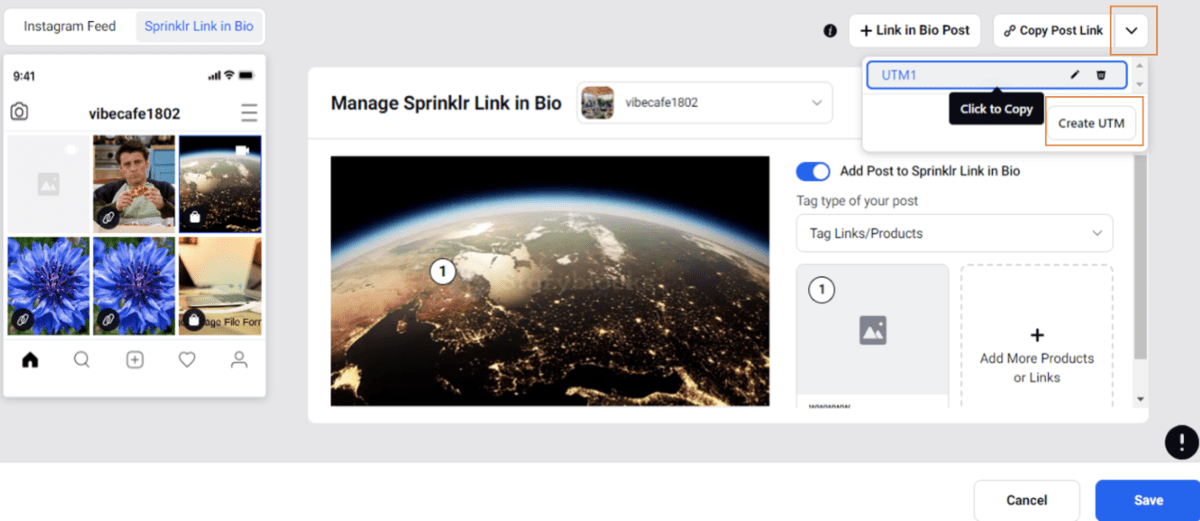You’re not alone if you find measuring your social media engagement hard. We have all been there.
Today, crunching the follower count on your social media account alone isn't going to cut it. There's so much to consider, like the dozens of metrics you have to monitor on different platforms, making it all the more challenging to have a consistent and unified approach.
And let's not forget the struggle between vanity metrics and actionable ones — it's tempting to focus on likes, shares and follower count, but they might not always align with your actual goals.
It’s important to also know:
How many new customers do you get through social media?
What percentage of your website traffic comes from, let’s say, Facebook?
What type of content (text, image, video, etc.) works best?
What’s the sentiment across your brand mentions and comments?
Another blocker is to figure out what's a good benchmark for your industry or how you compare against your competitors’ performance. It can be tricky to find reliable and public data for that.
And we can’t really say:

The only way you can improve your social media engagement strategy: Learn how to strike a balance between hard numbers and, without question, qualitative insights.🤌
Before we learn how to measure social media engagement effectively, let’s quickly recap what social media engagement is and why it is so important to measure it.
What is social media engagement?
Social media engagement refers to the level of interaction, involvement and responsiveness users have with your social media content. It goes beyond mere likes or followers and includes actions like comments, shares, mentions and direct messages.
Different platforms measure engagement in distinct ways and the importance of specific engagement metrics can vary based on the platform and its users’ goals. For example:
Likes and reactions: indicate users' interest or enjoyment
Comments: show that the content sparked discussion or elicited a response
Shares and retweets: demonstrate content's value and popularity
Clicks and link interactions: show users actively exploring beyond the post
Mentions and tags: increase visibility and foster community engagement
Direct messages: lead to deeper connections and personalized interactions
Why is measuring social media engagement so important? Long story short, to improve social media engagement. The sole purpose of social media platforms is to captivate and retain their intended audience. And this remains valid whether we are individual users, brand pages or investing millions in advertising on their platforms.
And not much to my surprise, a staggering 60% of the world's population, which is more than half of the world, now actively engages on social media. Add to it, sales via social media are expected to reach almost $1.3 billion by 2023.
The saying goes: be where your customers are. But how to make the most of it? Measuring social media engagement helps in doing just that and then some:
Aids in optimizing content creation for improved engagement: is a post with an image performing better than a video post or the other way around?
Plays a role in benchmarking against industry rivals and identifying competitive gaps: how can you outrank your competitors?
Crucial for mitigating the impact of negative events on the brand: what’s the customer sentiment across social media platforms when connecting with your brand?
And the most important “why” of measuring social media engagement: It assists in justifying social media marketing investments. We all know how important budgets are for marketing. Don’t we? 🥹
🚀 Supercharge your team with the power of AI
Unlock your team's full potential in social media engagement with Sprinklr AI! In just 30 minutes, discover how to revolutionize your productivity with these key features:
🎯 Smart triage: Automatically categorize incoming messages by intent, saving you time and hassle.
💬 Quick replies: Get AI-driven conversation suggestions to speed up and enrich customer interactions.
📈 Powerful publishing: Enhance your content strategy with advanced tools like Asset Manager and detailed Reporting Dashboards for all your channels.
Don’t miss out on maximizing your engagement efforts. Experience firsthand how Sprinklr AI can transform your social media strategy.
9 important social media engagement metrics you need to track
There are several social media metrics to track but you’ve got to accurately track your campaigns to know how they're performing, who's checking out your posts and what the users’ response is like. But remember, no single data set is the ultimate measure of success.
Check out these nine crucial metrics you should measure:
1. Impressions
Counting impressions reveals how many times your content pops up in users' feeds, and it can be more than once, regardless of whether they have interacted with it. So you may have significantly more impressions than your page’s total followers.
2. Reach
Reach is like impressions, but it doesn't count how many times your content has been viewed; rather, it tracks the number of unique viewers.
💡Pro Tip: Calculate what percentage of your reach is made up of followers vs. non-followers. A lot of non-followers interacting with your content implies that it’s being shared or doing well per the algorithms, or both.
Learn more: Social Media Reach vs Impressions: What’s the Difference?
3. Audience growth rate
Instead of being fixated on your follower count, monitoring your audience growth rate (month-to-month) offers valuable insights into the appeal of your content to new audiences. The formula requires you to divide the new followers by your total audience and then multiply by 100.
4. Engagement rate (by total followers)
To check how active your followers are when they interact with your social posts, just take the number of engagements (likes, comments, shares) and divide it by the total number of people who saw your post (reach). This will give you your engagement rate.
The higher the engagement rate, the better. A higher rate means your followers are finding your content interesting and engaging.
5. Engagement rate (by impressions)
Social media algorithms are constantly evolving, so they might not show every post you publish to all your followers. And with the popularity of explore pages and the like, there are plenty of people who are not direct followers and might be seeing your content.
Engagement rate (by impressions) takes this into account by considering the TOTAL views your content receives rather than solely the engagement from your followers.
6. Click-through rate (CTR)
The CTR represents the percentage of viewers who click a link on your post. Calculate it by dividing clicks by impressions. A strong CTR indicates your audience saw your social content and wanted to know more.
7. Social conversions
When an individual buys from your website through a social media link, it results in a social media conversion. This metric reveals the precise count of your followers who purchase your offerings. You can monitor this using UTM codes in your URLs and work out the conversion rate by dividing clicks by conversions.
💡 Pro Tip: Using a UTM manager by advanced platforms like Sprinklr Marketing you can add UTM parameters seamlessly to your URL’s and track the source, medium, campaign and other relevant information about the link's origin and the context in which it's being clicked.

8. Social share of voice (SSoV)
Social media share of voice (SSoV) gauges your brand's chatter versus competitors'. Think social media competitor analysis: how visible, and therefore, relevant, is your brand in the market?
Calculate social share of voice by tallying brand mentions across all social networks. Repeat this for competitors. Combine both sets of mentions to derive the total mentions for the industry. Divide brand mentions by industry total and then multiply by 100 to obtain the SSoV percentage.
Do not forget: Both direct mentions (e.g., “@Sprinklr”) and indirect mentions (e.g., “sprinklr”) count as share of voice on social media.
9. Social sentiment
While SSoV monitors your brand’s share of the social conversation, social sentiment gauges the emotions and opinions driving the conversation. When individuals discuss your brand on the internet, do their remarks lean toward positivity or negativity?
To analyze social media sentiment, you rely on social listening tools like Sprinklr that sort and make sense of the language and context.
We’ve got a whole guide so you can explore the what, why and how of social media sentiment analysis. The guide also includes steps on how to perform sentiment analysis and tips to improve your sentiment analysis using a tool. Save it for later!
Eager to try out the tool? You can try it for FREE right here 👇
How to measure your social media engagement: A 3-step approach
We all know how every social media platform comes with its own built-in analytics. But if you want to dig even deeper and get solid metrics to track how engaged your audience really is, a social media management and automation tool should be your go-to solution.
Here’s a 3-step approach to measuring social media engagement.
Step 1: Define your social media engagement objectives
What really matters is how social media can fuel your business goals and marketing strategy. However, this varies greatly across businesses. Take, for instance, a big international marketing agency versus a small local business – their social media aims differ. Here are some examples for social media engagement objectives:
Building brand awareness and connecting with ideal customers: Consider a multinational tech firm specializing in AI solutions. They can leverage platforms like LinkedIn and X to share industry insights and case studies, positioning themselves as AI experts. This approach not only boosts brand visibility but also cultivates connections with potential clients seeking their expertise.
Generating leads and boosting sales: Motivate users to schedule sales appointments through contact forms. Plus, track clicks from social media to your website or sales channels.
Enhancing employer branding: Picture this cool design agency rocking Instagram and YouTube. They pull back the curtain on their creative process, share stories from their team and drop nuggets of design wisdom. All of this paints a picture of their awesome culture and attracts folks who relate with their innovative vibe, making it a magnet for talented individuals looking for an exciting workplace.
Once you align your social media efforts with your business and marketing goals, focus on measuring your progress toward the objectives you set.
Step 2: Select apt social media engagement KPIs to track
As earlier mentioned, there are several social media engagement metrics to track. The best way to select the essential metrics to track the effectiveness of your social media strategy is to refer to your campaign or company goals.
Select metrics that are closely aligned with your objectives and can be effectively explained to your stakeholders as to why you have opted for these particular metrics.
Objective | KPIs |
reach, impressions, brand mentions, follower growth, SSoV | |
Website traffic | click-through rate (CTR), referral traffic, landing page views |
clicks on CTA, conversion rate, downloads of gated content | |
Sales | conversion rate, revenue generated, cost per conversion |
engagement rate, customer retention rate, customer feedback, customer sentiment |
Step 3: Build a unified social engagement report
Big decisions could happen when executives go through a report. Stakeholders get a crystal-clear picture of how your social media moves turn into tangible business results — like sales spikes, brand boosts and those awesome brand interactions we all love.
Remember, each social platform has its own built-in analytics, as I mentioned earlier. But since campaigns often sprawl across various platforms and accounts, doing the copy-paste shuffle and playing messenger between pro-social media managers becomes a real chore. Spare your team the grind by letting automation handle the copying and pasting.
And guess what? Less fussing with reports equals more quality time to really dig into those numbers. You can dissect what those metrics are shouting about the business and put together smart strategies for what's up next.
Dive deeper: Read The Ultimate Guide to Social Media Reporting
How Lenovo paired the right content to the right audience to drive engagement
Every year, Vegas hosts tech giants at the International Consumer Electronics Show. Brands unveil innovations, turning the event into a marketing frenzy.
Lenovo’s goal: boost global brand awareness and spotlight its latest products
Its tactic: Ace audience targeting and fuel hype around key projects.
Its platform of choice: Facebook, Instagram, X and LinkedIn.
The solution it adopted: Sprinklr Social.
✅ Sprinklr's data spotlighted two gems: recent engagements with Lenovo's X (top engagement) and users buzzing around CES hashtags, linking Lenovo with tech media and partners.
✅ At their booth, Lenovo wowed with a Star Wars Jedi game, a Disney collab to flaunt the Mirage AR headset. Using Sprinklr's Twitter Firehose data, they laser-targeted Star Wars fans, drawing them to this tech marvel.
The result?
↘️ 73% decrease in cost per engagement
↗️ 6.5x increase in engagement rate
Signing off
Social media success hinges on engagement. Every brand wants more engagement on their posts, but those pesky algorithms? They are as unpredictable as the daily weather forecast.
Here's the deal: you can always boost engagement. There are absolutely no limits whatsoever. So, gear up, measure it right with Sprinklr and let your engagement soar.
You can save hours spent exporting metrics by using a social media management platform like Sprinklr. Not only will you be able to track your entire social media performance on 30+ digital and social channels in one unified platform, you can also focus your time and energy on results that matter the most.
With Sprinklr Social, you can:
Monitor your brand's mentions, keywords and hashtags on social media
Measure the frequency and sentiment of discussions about your brand — positive, negative, neutral
Assess social media performance against competitors — identifying market standing and improve opportunities
Utilize unique tracking links to measure social media campaign success — pinpointing high-traffic, conversion-driving channels
Get instant notifications for events and mentions — responding quickly to customers and potential crises





![10 AI Writing Prompts In Content Marketing [2024]](https://images.ctfassets.net/ukazlt65o6hl/7BXUq8Ns0vCgornXApT0Uz/572755ba099aecf279675903caf526b6/Blog_Banner_Image.png?w=750&h=505&fl=progressive&q=70&fm=jpg)

